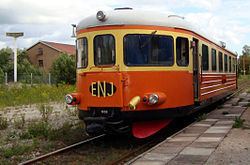Length 18 km (11 mi) Opened December 1853 | Closed to passengers 1962 | |
 | ||
Original gauge 1,188 mm (3 ft 10 ⁄32 in)untill 1876, converted to1,435 mm (4 ft 8 ⁄2 in)at that year Operated by Engelsberg-Norberg Heritage Railway Association Preserved gauge 1,435 mm (4 ft 8 ⁄2 in) standard gauge Similar Engelsberg Ironworks, Raffinerie Engelsberg, Möja Jernväg, Ecomuseum Bergslagen, Föreningen Böda Skogsjärnväg | ||
Engelsberg–Norbergs Järnväg, the Engelsberg–Norberg Railway, is a 1,435 mm (4 ft 8 1⁄2 in) standard gauge railway between Ängelsberg and Kärrgruvan in the province of Västmanland in Sweden, now being used by the Engelsbergs Norberg Järnvägshistoriska förening (ENJ), a heritage railway association.
Contents
History
The 18 km (11 mi) long railway line was built in the 1850s with the purpose of transporting iron ore between the Norberg mining area and the lake Åmänningen, for further transport on barges on the Strömsholm Canal. Transport of goods on the first part of the line, Kärrgruvan – Trättbo begun in December 1853 with the first steam engine built in Sweden, Förstlingen (the First One), constructed by the Munktell Mechanical Workshops in Eskilstuna. A reconstructed company, Norbergs Nya Järnvägs AB was formed in 1855 and finished the whole line to Ängelsberg at the lake of Åmänningen in 1856. At that time the railway had a 1,188 mm (3 ft 10 25⁄32 in) gauge, widened to the Swedish 1,435 mm (4 ft 8 1⁄2 in) standard gauge in 1876.
In 1962 passenger service was discontinued, followed by freight services in the mid 1990s.
The Heritage Railway Association
Engelsbergs Norberg Järnvägshistoriska förening (ENJ), the Engelsberg-Norberg Heritage Railway Association, started in 1999, aims to organize regular traffic for tourists with diesel railcars between Ängelsberg and Kärrgruvan. The association has two locomotive sheds, including a roundhouse and turntable at Ängelsberg and a shed at Kärrgruvan. The latter was built in 1857 and is the oldest preserved locomotive shed in Sweden.
ENJ uses three 1950s railcars for regular traffic:
ENJ also has other stock for permanent way and maintenance use, including:
As well as various coaching stock awaiting restoration in the sidings at Kärrgruvan. ENJ's long term hopes are to run a summer steam service on the line, and has secured these coaches to be used when appropriate motive power becomes available. For now, the railcars provide the backbone of the service.
Note
This article is based on the article about the Engelsberg-Norbergs Järnväg in the Swedish language Wikipedia.
